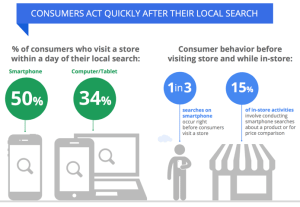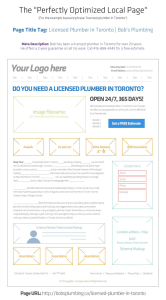The reality can be harsh: No traffic, no sales.
Many business owners face this exact scenario.
The fact remains that simply having a site is no longer enough to rank well in the search results. Evolving search algorithms combined with a much more competitive landscape has practically guaranteed this. So a different approach is needed, one that establishes a strong brand and drives measurable results.
Just as the largest brands in the world invest heavily in their marketing, the same applies here.
Marketing a small business online is a continuous effort. It’s not a one-time thing that delivers instant results. In fact, it can take months to start seeing results with internet marketing strategies such as SEO. But those efforts start paying off once your site gains momentum.
Whether you sell products or deliver services to a local market, the strategies below are proven ways to drive targeted traffic to your site.
1. Optimize On-Page Factors
No one uses Yellow Pages anymore.
Most consumers now go online to find local businesses. A study by Google analyzing search behavior found that 4 out of 5 consumers use search engines to find local business information (e.g. store address, hours, directions, etc.). Not surprisingly, many of these searches led to purchases and store visits.
Why is this important?
Because it demonstrates the importance of local search. Your business benefits from more targeted traffic and potential sales. But only if your site is visible for target keywords.
So how can you increase your search engine rankings for local search? Remember that Google aims to deliver the most relevant results for every search query. So the first step is to optimize all on-page factors to improve the relevance of your pages.
Here’s how:
- Conduct keyword research: The first order of business is to determine the keywords to target. These are the keywords that your target market will be typing directly into the search engines to find your business. Use Google’s Keyword Planner to search for keyword ideas.
- Optimize page titles: One of the most important on-page factors is the title tag. This is what users immediately see in the search results. So write an engaging title that includes your target keywords and the name of the city (e.g. SEO services in Austin).
- Optimize meta descriptions: Meta descriptions are brief snippets of text that are found beneath the title and URL in the search results. Write a brief description about the page and include your main keywords as well as other details (e.g. contact information, hours, etc.)
- Optimize content: Use target keywords in your content to improve its relevance and include multimedia (e.g. images, videos, etc.) to increase visitor engagement. But be careful with keyword usage or you risk getting hit with a ranking penalty.
Optimizing on-page factors is a critical first step. But equally important is displaying prominent contact information on every page. Visitors want to be able to quickly find what they are looking for without having to trawl through reams of information.
Refer to the graphic below of a well optimized local page:
2. Provide Value With Engaging Content
Content is the new marketing.
The Content Marketing Institute defines content marketing as the following:
“Content marketing is a strategic marketing approach focused on creating and distributing valuable, relevant, and consistent content to attract and retain a clearly-defined audience—and, ultimately, to drive profitable customer action.”
Advertising has become so pervasive that more consumers now ignore online ads. But providing engaging content has proven to be especially effective at improving visibility online and driving conversions. It’s not hard to see why as engaging content provides value.
Perhaps the biggest benefit is the ability to drive quality leads.
Marketers that blog on a regular basis receive 67% more leads and are more likely to enjoy a positive ROI than those that don’t. Engaging content not only attracts more links, but also establishes your brand as an authority.
Here are some content ideas to get started with:
- Blogging: Blogging allows you to share your expertise and attract search engine traffic. Use the keywords in your research from the earlier step for topics to blog on.
- Ebooks: Create an ebook that covers a topic in complete detail. Then leverage it to drive more leads or increase subscribers to your newsletter.
- Videos: Creating and sharing videos is another great way to drive targeted traffic. Create a tutorial series, demonstrate your product in use, or cover local events. Post to your site or share on many of the video sharing sites such as YouTube or Dailymotion.
- Case studies: Use case studies to highlight testimonials and how customers have benefited from your product or service. These can be covered in blog posts or videos.
- Infographics: Infographics are visual representations of bite-sized information. These make it easy for visitors to view and are especially popular on social media platforms.
Mix up different types of content into your marketing and consider creating an editorial calendar to track your efforts. Always focus on quality, not quantity as each of content you create is essentially an extension of your brand.
3. Engage With Your Audience on Social Media
Talking about internet marketing or SEO is nearly impossible without mentioning social media.
It’s become increasingly clear that social media is a key component of a marketing strategy. Facebook alone now has over 1.4 billion monthly active users. Other popular networks include Twitter and Google+. And more companies are even beginning to use Instagram and Snapchat to reach younger audiences.
One statistic that simply cannot be ignored is that 46% of online users turn to social media for purchasing decisions. This is yet another reason why your business should maintain active profiles. Because they allow you to reach and connect with more of your audience.
Here are basic guidelines to make the most out of each social network:
- Maintain a clean design: Impressions matter. Use professional images in your profiles that reflect your brand and always include key details about your business.
- Optimize for local keywords: Just as you want to optimize your pages for local keywords, the same applies here. Be sure to optimize each profile for your target keywords to increase their search engine visibility.
- Post and share content: Engaging content is what attracts more shares. Post content that you created in the earlier step but remember to share other pieces you think your followers might find useful. Only promoting your own content runs the risk of getting banned.
- Make it easy to share: To improve your WordPress SEO, there are a number of plugins available that make it easy for visitors to share your content.
No matter how you look at it, social media is an effective marketing tool you can leverage to engage with your target audience and drive more targeted traffic. This level of engagement further boosts your visibility online.
Conclusion
More traffic. More sales. It sounds easier said than done. But it’s entirely possible to drive targeted traffic to your pages by leveraging content creation and social media into your marketing. Both of which give your business a serious competitive advantage online.


